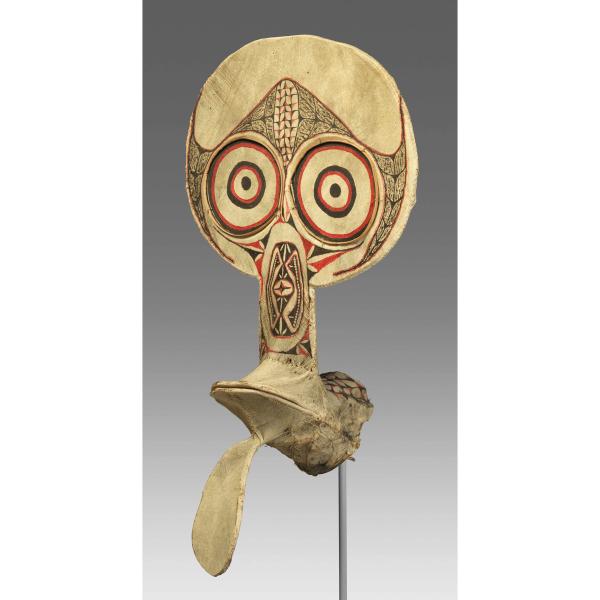Mask (Kavat)
The night dance, by contrast, is accompanied by a male orchestra and dedicated to spirits, animals, and commodities associated with the surrounding forest, which are represented by the kavat masks. Several dozen forms of kavat masks exist, each of which depicts a spirit linked with a specific animal, plant, product, or activity associated with the forest. The rounded form of this mask suggests that it portrays a leaf spirit.
Artwork Details
- Title: Mask (Kavat)
- Date: 1973
- Geography: Papua New Guinea, New Britain
- Culture: Kairak Baining people
- Medium: Bamboo, barkcloth, paint
- Dimensions: H. 54 x W. 30 x D. 14 in. (137.2 x 76.2 x 35.6 cm)
- Classification: Bark-Sculpture
- Credit Line: Gift of George and Sarah Corbin, 2005
- Object Number: 2005.460.1
- Curatorial Department: The Michael C. Rockefeller Wing
Audio

1735. Kavat (masks), Kairak Baining artists
Wylda Bayrón
KATERINA TEAIWA (NARRATOR): When a mask like this is displayed in a gallery, it’s shown without all of its human, ceremonial, and environmental context...
WYLDA BAYRÓN: …without the human wearer, without the leaves of the forest. That’s why I think that the medium of photography is really important, because you, in one instant, can fill that void.
My name is Wylda Bayrón, and I’m an indigenous Taíno and Arawak from Puerto Rico. And I am a cinematographer and photographer. I’ve been photographing New Guinea for the last decade.
It is my understanding that when the dancers are wearing the mask and dancing, it is invoking the spirit of the plants and animals of the forest.
KATERINA TEAIWA: The Baining people in New Britain, an island off the coast of New Guinea, wear these masks during fire dance ceremonies.
WYLDA BAYRÓN: Preceding the fire dancers, there is a choir. They have these very small hollowed out drums that are beaten with short, quite thick sticks, and they make like a little tac, tac, tac, tac, tac sound, and the chanting is quite high pitched. It’s got this very strange rhythm, and it just becomes this beautiful cacophony. Eventually, the fire starts being made, and it’s a fire that’s 15 feet tall, 15 feet wide, quite massive.
KATERINA TEAIWA: Then, the dancers emerge from the forest.
WYLDA BAYRÓN: And each dancer spends five to ten minutes doing their dance and invoking their spirits, kicking the fire around, and it’s very, very enthralling.
KATERINA TEAIWA: A Baining man named Mr. Brown told Wylda how masks are decorated.
WYLDA BAYRÓN: He explained to me that the red in the mask was created by scraping the tongue of the wearer and using the human blood to create the red. The black was made with charcoal from the fire that they dance in.
The making of any traditional dress is a moment of sharing information. Getting the materials from the forest, explaining to the children which material it is. It’s not this leaf, it’s that leaf. So, maintaining that knowledge alive is why the ceremonies have gone on for hundreds of years.
More Artwork
Research Resources
The Met provides unparalleled resources for research and welcomes an international community of students and scholars. The Met's Open Access API is where creators and researchers can connect to the The Met collection. Open Access data and public domain images are available for unrestricted commercial and noncommercial use without permission or fee.
To request images under copyright and other restrictions, please use this Image Request form.
Feedback
We continue to research and examine historical and cultural context for objects in The Met collection. If you have comments or questions about this object record, please contact us using the form below. The Museum looks forward to receiving your comments.
